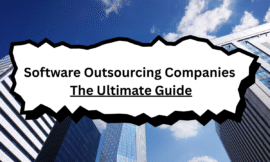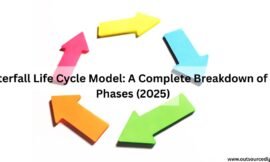The Agile Model in software development is an approach that embraces change, encourages collaboration, and delivers value incrementally. For businesses outsourcing software projects, Agile is often the go-to model for managing distributed teams and ensuring continuous improvement.
This guide breaks down the Agile model, its core principles, and how to apply it effectively in outsourced environments. Whether you’re a startup founder or a technical manager, you’ll learn how Agile can accelerate your product roadmap while maintaining quality and alignment.
New to the broader SDLC process? Start with our Complete Guide to the Software Development Life Cycle.
What Is the Agile Model in Software Development?
The Agile model is an iterative and incremental approach to software development that prioritizes:
- Customer collaboration
- Working software over documentation
- Adaptability over rigid planning
- Individuals and interactions over tools
Agile moves away from the “big bang” approach of traditional models like Waterfall, favoring short development cycles (called sprints) where teams build, test, and refine features based on feedback.
This makes Agile ideal for projects where requirements evolve, such as in startups, SaaS platforms, and tech products driven by user input.
The Agile Manifesto: Foundation of Agile Thinking
Introduced in 2001, the Agile Manifesto outlines four core values and 12 principles.
The 4 Core Values of the Agile Manifesto
- Individuals and interactions over processes and tools
Agile emphasizes the importance of human communication and teamwork, recognizing that strong collaboration delivers better results than rigid reliance on tools or formal procedures.
- Working software over comprehensive documentation
While documentation has its place, Agile prefers functional software as the true measure of progress. The focus is on delivering value quickly, not just writing about it.
- Customer collaboration over contract negotiation
Rather than sticking to strict contracts, Agile encourages continuous dialogue with customers to align expectations and adapt as needs evolve.
- Responding to change over following a plan
Agile values adaptability. It accepts that requirements can shift and promotes the ability to pivot strategies based on real-world feedback and changing priorities.
These values are particularly relevant in outsourcing, where collaboration, feedback, and trust are vital to success.
The Agile Manifesto is further supported by 12 principles that provide a practical framework for Agile project execution. These principles emphasize speed, customer value, technical excellence, and sustainable development.
The 12 Principles Behind the Agile Manifesto
- Our highest priority is to satisfy the customer through early and continuous delivery of valuable software.
- Welcome to changing requirements, even late in development. Agile processes harness change for the customer’s competitive advantage.
- Deliver working software frequently, from a couple of weeks to a couple of months, with a preference for the shorter timescale.
- Business people and developers must work together daily throughout the project.
- Build projects around motivated individuals. Give them the environment and support they need, and trust them to get the job done.
- The most efficient and effective method of conveying information to and within a development team is face-to-face conversation.
- Working software is the primary measure of progress.
- Agile processes promote sustainable development. The sponsors, developers, and users should be able to maintain a constant pace indefinitely.
- Continuous attention to technical excellence and good design enhances agility.
- Simplicity—the art of maximizing the amount of work not done—is essential.
- The best architectures, requirements, and designs emerge from self-organizing teams.
- At regular intervals, the team reflects on how to become more effective, then tunes and adjusts its behavior accordingly.
Learn how Agile compares to Waterfall: Agile vs. Waterfall in Outsourced Software Projects
Agile Frameworks Commonly Used in Outsourced Projects
Agile isn’t a single methodology—it’s a mindset implemented through various frameworks. Here are the most popular ones in 2025:
- Scrum
- Work is divided into 1–4 week sprints.
- Includes roles like Product Owner, Scrum Master, and Development Team.
- Regular ceremonies: sprint planning, daily standups, sprint reviews, retrospectives.
- Kanban
- Focuses on visualizing tasks and limiting work-in-progress.
- Best for teams handling ongoing tasks like maintenance, QA, or DevOps.
- Scrumban
- A hybrid model combining Scrum’s structure with Kanban’s flexibility.
- Ideal for outsourced teams with varying workloads.
Benefits of the Agile Model in Outsourced Environments
Agile is a natural fit for outsourcing because it supports:
- Faster Feedback Loops: Regular reviews help detect misalignment early and avoid major rework.
- Incremental Delivery: Clients start seeing working features within weeks, not months.
- Flexibility to Evolve: Agile welcomes change, making it easier to adapt the product based on user or market feedback.
- Improved Transparency: Frequent communication, progress boards, and sprint demos foster visibility.
Related: How to Ensure Transparency in Each SDLC Stage
Challenges of Using Agile in Outsourcing
Despite its advantages, Agile isn’t a silver bullet. Challenges include:
- Time Zone Barriers: Daily standups and real-time reviews can be difficult with offshore teams.
- Misaligned Expectations: Some outsourcing vendors claim to be “Agile” but lack true cross-functional teams or iterative workflows.
- Limited Client Involvement: Agile thrives on collaboration—clients must be actively involved to succeed.
Best Practices for Agile Outsourcing Success
To make the most of Agile in a distributed setup, follow these principles:
- Define Roles Clearly
Ensure that the Product Owner (often client-side) and Scrum Master (vendor-side) collaborate closely.
- Use the Right Tools
- Project Management: Jira, ClickUp
- Documentation: Confluence, Notion
- Communication: Slack, Microsoft Teams
- Code & DevOps: GitHub, GitLab, CircleCI
- Ensure Daily Communication
Even brief async updates can keep both sides aligned.
- Set a Realistic Sprint Cadence
Account for time zones, team size, and velocity when planning sprints.
- Automate Testing and Deployment
CI/CD pipelines and test automation ensure consistent quality in every sprint.
Tip: See our QA Integration in SDLC for testing best practices in Agile environments.
When Should You Choose Agile?
Agile is ideal if:
- Your requirements are evolving
- You need rapid feature releases
- You value early and continuous feedback
- You’re building an MVP or SaaS product
- Your team can commit to regular reviews and collaboration
On the other hand, Agile may not be the best choice if your scope is fixed, stakeholders are unavailable for feedback, or your vendor lacks Agile maturity.
Conclusion
The Agile Model in software development has become the standard for modern, fast-moving projects, especially in outsourced environments where responsiveness and adaptability are key. By understanding Agile’s principles, selecting the right framework, and implementing best practices, companies can build better software faster and more collaboratively in 2025.







